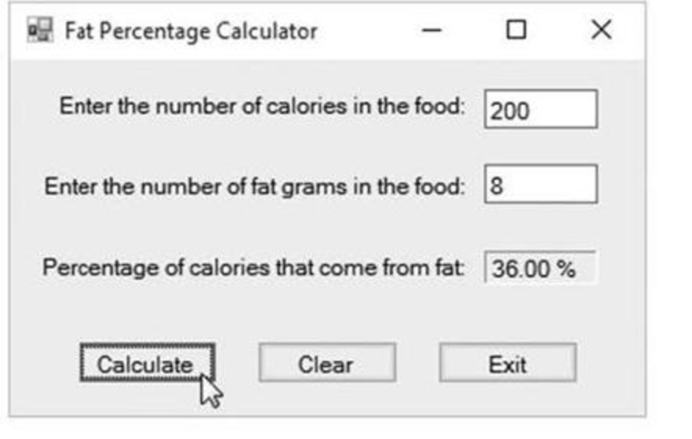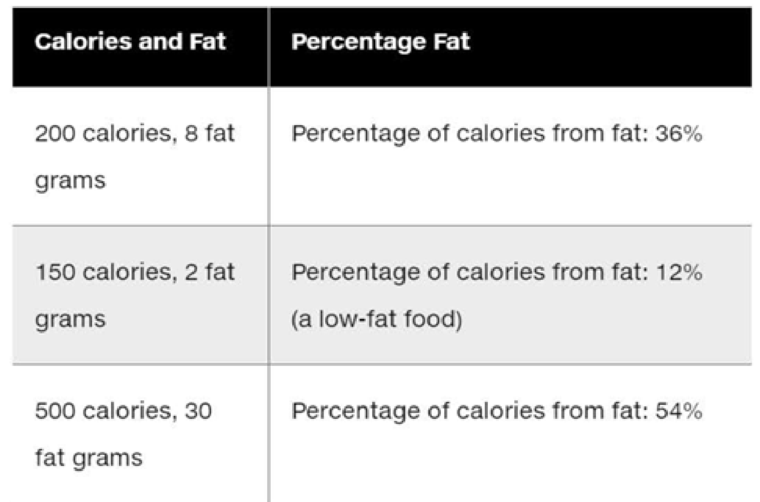
Fat Percentage Calculator
Create an application that allows the user to enter the number of calories and fat grams in a food. The application should display the percentage of the calories that come from fat. If the calories from fat are less than 30% of the total calories of the food, it should also display a message indicating the food is low in fat. (Display the message in a label or a message box.) The application's form should appear similar to the one shown in Figure 4-35.
Figure 4-35 Fat Gram Calculator form

One gram of fat has 9 calories, so:
Calories from fat = fat grams * 9
The percentage of calories from fat can be calculated as:
Percentage of calories from fat - Calories from fat / total calories
Input validation: Make sure the number of calories and fat grams are numeric, and are not less than 0. Also, the number of calories from fat cannot be greater than the total number of calories. If that happens, display an error message indicating that either the calories or fat grams were incorrectly entered.
Use the following test data to determine if the application is calculating properly:

Want to see the full answer?
Check out a sample textbook solution
Chapter 4 Solutions
Starting Out With Visual Basic (8th Edition)
Additional Engineering Textbook Solutions
Java How to Program, Early Objects (11th Edition) (Deitel: How to Program)
Starting Out with C++ from Control Structures to Objects (9th Edition)
Management Information Systems: Managing The Digital Firm (16th Edition)
Java: An Introduction to Problem Solving and Programming (8th Edition)
Computer Science: An Overview (13th Edition) (What's New in Computer Science)
Web Development and Design Foundations with HTML5 (8th Edition)
- Select all the possible polar representations of the vector that is obtained from rotating where by Zrot Ź x = 3e² T= 3п 8 Hint: Consider the negative angle that is equivalent to the positive angle of the rotated vector. 0arrow_forwardCharacter Analysis If you have downloaded the source code you will find a file named text.txt on the Chapter 08 folder. Write a program that reads the file's contents and determines the following: The number of uppercase letters in the file The number of lowercase letter in the file The number of digits in the file The number of whitespace characters in the filearrow_forwardWrite a program that reads the text file's contents and calculates and outputs the following in this order: • The number of words in the file • The number of lines in the file • The number of uppercase letters in the file • The number of lowercase letters in the file • The number of digits in the file • The number of letter H's in the file • The number of whitespace characters in the file NOTE: Your program should include at least one try-except error handling statement block. Your program should also validate any input that could cause your program to crash. I'm Henery The Eighth, I Am! Henery The Eighth, I Am, I am!I got married to the widow next door,She's been married seven times before.And ev'ryone was a Henery,She wouldn't have Willie or a Sam.I'm her eighth old man named Henery,Henery the Eighth, I Am!Second verse same as the first!I'm Henery The Eighth, I Am! Henery The Eighth, I Am, I am!I got married to the widow next door,She's been married seven times before.And…arrow_forward
- Figure 4-40 Modern Database Management, 13th edition, question 4-53arrow_forwardWhich of the following needs improvement in the dashboard shown? A. Instructional clarity missing for the views B. Filter placed at the top of the dashboard C. Inconsistent use of colors to represent missed goals D. Dashboard title too largearrow_forwardIf we click Show dashboard title in this dashboard, what will the title be?arrow_forward
- Please draw the diagram where it is asked to be drawn. Don't just describe how to do it.arrow_forwardC. Homework Assignment Task: Write a one-page CV using the provided template. Steps: 1. Use the CV guide to structure your CV. 2. Fill in each section with real information about yourself. 3. Format your CV neatly and use professional language. 4. Submit to the instructor before the next classarrow_forwardSimulate on a vertical time axis (with events labeled with the senders names A-D) the contention period of FOUR equally distanced Ethernet stations that all attempt to transmit at T=0 a minimally sized frame, in the style of the binary Exponential Backoff Algorithm. Assume that time is measured in slot times, and that exactly one slot time is needed to detect a collision (so that if two stations transmit at T=1 and collide, and one of them chooses a backoff time k=0, then that station will transmit again at T=2). Use as coin flip (source of randomness) an ID written in binary. use the bits in order from the least significant to the most significant. If for a given coin throw you need k bits, use the least significant ID bit extracted in the corresponding group of bits, as the least significant bit of the coin thrown. Start be writing the ID, which is 904012207 As example of the expected answer format, with the random sequence R: 100101010101001011001010 01 01011 10010 1010 1010 010…arrow_forward
- Big State University The Big State University course catalog reads as follows: "To enroll in MIS 260, which is an advanced course, a student must complete two prerequisites: MIS 120 and MIS 222. A student who completes either one of these prerequisites and obtains the instructor's permission, however, will be allowed to take MIS 260." Tasks 1. Create a decision table that describes the Big State University course catalog regarding eligibility for MIS 260. Show all possible rules. 2. Simplify the table you just created. Describe the results. 3. Draw a simplified decision tree to represent the Big State University catalog. Describe the results. 4. Why might you use a decision tree rather than a decision table?arrow_forwardWhat is the ALU result if the 4-bit ALU Control signal is 0100? What happens if the ALU Control signal is 0101?arrow_forward#include int main (void) { int i, *p, count } p = &count; = 10%; for (i = 5; i >= 0; i--) { count++; (*p) ++; } printf("count return 0; = %d, Have a wonderful day.\n", count); 1. [20 pts] What is the output of the program? Please explain why. 2. [15 pts] What is the gdb command to set a breakpoint in line 6 (p = &count;)? 3. [15 pts] Explain in your own words how the [break. need to use such command? ... if expr] command works. When might youarrow_forward
 Programming with Microsoft Visual Basic 2017Computer ScienceISBN:9781337102124Author:Diane ZakPublisher:Cengage LearningNp Ms Office 365/Excel 2016 I NtermedComputer ScienceISBN:9781337508841Author:CareyPublisher:Cengage
Programming with Microsoft Visual Basic 2017Computer ScienceISBN:9781337102124Author:Diane ZakPublisher:Cengage LearningNp Ms Office 365/Excel 2016 I NtermedComputer ScienceISBN:9781337508841Author:CareyPublisher:Cengage Microsoft Visual C#Computer ScienceISBN:9781337102100Author:Joyce, Farrell.Publisher:Cengage Learning,
Microsoft Visual C#Computer ScienceISBN:9781337102100Author:Joyce, Farrell.Publisher:Cengage Learning, EBK JAVA PROGRAMMINGComputer ScienceISBN:9781337671385Author:FARRELLPublisher:CENGAGE LEARNING - CONSIGNMENTProgramming Logic & Design ComprehensiveComputer ScienceISBN:9781337669405Author:FARRELLPublisher:Cengage
EBK JAVA PROGRAMMINGComputer ScienceISBN:9781337671385Author:FARRELLPublisher:CENGAGE LEARNING - CONSIGNMENTProgramming Logic & Design ComprehensiveComputer ScienceISBN:9781337669405Author:FARRELLPublisher:Cengage





